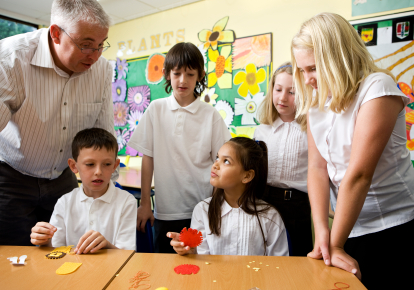

- A broad range of educators and community partners can collaborate to support social and emotional learning. As you draw up a list of potential partners, think strategically about the knowledge and resources each one can contribute. The “Think Broadly” activity can help you include key players, as well as members you might not have thought of at first. The “Who Cares As Much As You Do?” and “Where Does Our Work Intersect?” tools can help you to approach prospective partners with an understanding of the relationships among different early childhood programs in your community.Child care providers are key members of an early childhood education partnership. The majority of children from birth through age five attend community-based or family child care. To help ensure that children enter school ready to learn, you’ll need to engage these providers in your work. There are many kinds of child care settings to be represented: center-based child care, public school pre-K programs, family child care, Head Start, and faith-based preschools. There may also be an early childhood council in your community to include. This diversity will help you to reach all children with your initiative, not just those in formal preschool settings.It is now common for mental health centers to have staff members with early childhood expertise. Specialists like these can play a key role in your partnership, along with pediatricians or early interventionists. Parents and guardians are also key partners to consider. Parental engagement has been linked to school readiness skills, including academic performance and achievement, prosocial behaviors, and positive approaches to learning. By bringing together a range of partners concerned about healthy social and emotional development in early childhood, you can foster cooperation and innovation.With a list in hand of dynamic and diverse community leaders, you are ready to invite them to join your partnership. Use the “Share Your Message” interaction and the “How Do We Make Our Case?” tool to construct a message that is customized, concise, and convincing. When you approach potential partners, they’ll know right away that this is a worthwhile venture!
- Once you have partners on board, you can create a vision and a mission together. These will clarify how you hope to support the social and emotional development of young children in your community, and how you will structure your partnership to reach your goals. The “Where Does Our Work Intersect?” tool may be useful here too, helping partners learn about each other’s programming. With the “Connect the Dots” activity you’ll learn how to connect the motivations, values, and ideas of all your partners to create one vision.There can be tensions between parents and providers, and between partners from more professional settings and those from family or faith-based settings. Often there are significant differences in the populations served by those providers. The pediatricians and mental health clinicians in your partnership may lean towards formal assessment tools for children’s development, while the child care providers may rely more on experience or practice-based knowledge. Engaging parents as partners in these efforts can be challenging as well. As your partnership works to develop goals and a plan to support children’s social-emotional development, take care to include all of the members’ perspectives. A shared leadership model can help to support the participation of all. The “How Do We Create an Agreement for Working Together?” tool can help you preserve the understandings you come to on each challenging question.
 Start your planning with a firm understanding of the status quo. Work with your partners to identify your community’s needs and resources for early childhood social and emotional development. Basing your plan on this information will help you identify gaps in programming and avoid duplication of services.
Start your planning with a firm understanding of the status quo. Work with your partners to identify your community’s needs and resources for early childhood social and emotional development. Basing your plan on this information will help you identify gaps in programming and avoid duplication of services.
- To create an effective plan, your first task is to understand what needs exist, what services and resources are already in place for early childhood social-emotional learning, and where there are gaps. With the “What’s Really Happening” activity, you’ll assess your community’s needs and resources. The “How Do We Know What’s Happening?” tool provides tools and checklists to help you organize the information you gather. As you determine what issues you will address, consider collecting data on the following:
- Family demographics, such as numbers of teen parents, percentage of children living with a single parent or guardian, percentage of children living in homes where English is not the primary language
- The number of young children receiving services like early intervention, special education, and child protective services—and the nature of those services
- The percentage of children who attend preschool programs, and indicators of issues within those programs, such as expulsions
- Child care provider associations, councils, and referral systems, and any professional development programs connected to them
- Local, regional and state early childhood learning standards that include social-emotional learning either as a separate strand or embedded into other areas
- Social-emotional learning approaches used in your community’s early childhood programs
The information you collect will allow you to prioritize the most pressing needs,and address the gaps in existing services. At the same time, the partners will be creating a valuable shared knowledge base which can support further improvements and collaborations. - Once you understand your community’s needs and resources, decide as a team what outcomes will bring you to your goals, and what activities will produce those outcomes. The “Create Your Plan” activity will help you include some fundamental planning elements. The “How Do We Create Our Roadmap?” tool will guide you through a series of questions to help the plan flow logically, based on your circumstances.Your activities may focus on individual children, families, early childhood settings, or policy change within provider settings. There are evidence-based programs for working with young children and their parents together, such as home visiting programs that help model positive interactions so infants and toddlers and their parents can benefit and learn. In parent education groups, parents come together to strengthen their parenting skills and support one another. Some programs include support specifically for pregnant or parenting teens.Could local pediatricians routinely screen for social and emotional development during well-child checkups? There are quick and easy tools that can be administered in waiting rooms and examination rooms. Could the child care programs in your community share a mental health consultant to work with staff, families and peers to handle young children with challenging behaviors? As you consider different options for action, make sure to choose each one to match the needs and population you are dealing with. It may be necessary to adapt a plan that has been successful in a different setting, to make it work well in your own community.Finally, decide how you will evaluate your programming to determine whether you are achieving your desired results. How will you know if it’s working? There are tools you can use to evaluate childrens’ progress in social-emotional development, parents’ progress in learning specific skills, and other measures of successful early childhood efforts.
- Even while you are choosing programs, look for ways to make what you do sustainable. The “Create Infrastructure” activity can be helpful here, offering “TEAM CPR” to guide you through the essential components of effective implementation. The “How Do We Build for Success?” tool will be especially appropriate for evidence-based programs. Does your local school include early childhood social-emotional development in its School Improvement Plan? Can you collaborate with the special education department to serve children in community-based programs? If multiple agencies provide parent education, could they coordinate and reach more parents? If an early childhood association offers professional development for preschool educators, could mental health and medical providers be included too? You can strengthen your implementation by connecting the activities of different groups that serve young children.One way to build infrastructure is with professional development High-quality trainings can increase the capacity of providers and educators. You might consider offering:
- Learning opportunities, including manuals, tutorials, skills practice, and online lectures or discussion
- Coaching and consultation focused on reinforcing skill development and applying desired skills while working with children and families
- Communities of practice for people to share their knowledge, skills, and observations in a specific early childhood education area
 Now that you have your partners on board and your plan in place, it’s time for action! Be sure to monitor implementation to ensure that everything is going forward as planned. Communicate regularly with your partners and use your data to make any necessary program adjustments. Excellence in implementation will help you identify gaps and avoid duplication of services.
Now that you have your partners on board and your plan in place, it’s time for action! Be sure to monitor implementation to ensure that everything is going forward as planned. Communicate regularly with your partners and use your data to make any necessary program adjustments. Excellence in implementation will help you identify gaps and avoid duplication of services.
If you are using evidence-based interventions, such as a parenting education program, it is important first to implement “with fidelity,” that is, exactly as designed. As you and your partners review the results, you can focus your efforts on those program components that are helping you reach your goals, and refine or phase out those that are not working. On the positive side, whenever you can point to concrete results, your partnership is in a good position to advocate for the continuation of your programs: Are fewer children being expelled from preschool? Do parents report they are more confident in their parenting skills? Do pediatricians see gains in social-emotional development or an increase in appropriate referrals to early intervention? Your partnership should be able to answer these questions if you have followed your plan.
- Together, the “Create a Legacy” activity and the “How Can We Sustain Our Efforts?” tool will help your partnership find ways to sustain successful programs, so that the positive impact of your work to support social and emotional learning will be long-lasting.To help your early childhood efforts last into the future, look for ways to align with the latest work in social-emotional learning standards. This will connect your partnership with others who are committed to similar strategies, and will also help you match your proven successes to funding opportunities. For example, many states have adopted rigorous, widely shared standards and assessments that address social-emotional learning in early childhood.Another important step is to raise awareness in your community. Is early childhood social-emotional learning on the agenda of your mayor, your governor, and your legislators? Advocacy and public information will help to foster buy-in and widespread support for your initiative.The “How Do We Use Data to Communicate?” tool will help you translate your successes into sustainability.

